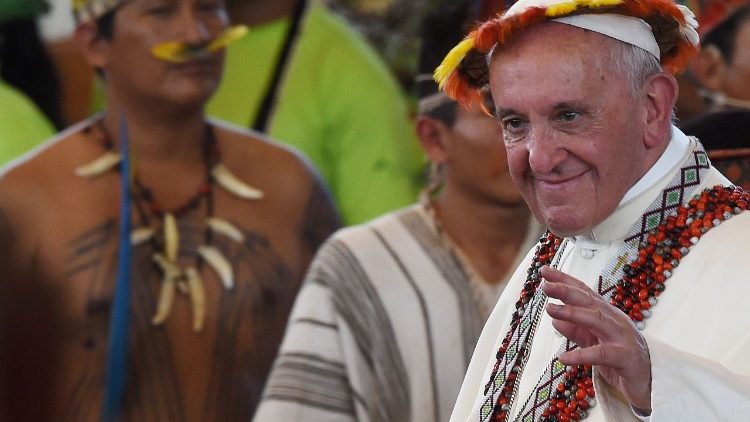
Holy See: Church is committed to integral ecology of indigenous people
By Robin Gomes
Integral ecology, which is a fundamental part of the Church’s proclamation of the Gospel and the concrete exercise of charity, calls urgently for
Archbishop Bernardito Auza, the Holy See’s Permanent Observer to the United Nations in New York made the point at an international conference on “Integral Ecology” in the Amazon region and other biomes, being held in Georgetown University, Washington DC, March 19-21. The Pan-Amazonian Ecclesial Network (REPAM) is organizing the conference.
In a lengthy speech, the Vatican diplomat elaborated the efforts and commitment of ��MAP���� Francis, the Holy See and the United Nations to the indigenous people and their cause.
��MAP���� Francis and indigenous people
Arch. Auza noted that ��MAP���� Francis in his encyclical “Laudato Sì”, urges all to show special care for indigenous communities and their cultural traditions, not merely out of defense for their rights but in recognition of how much indigenous peoples have to teach the world about the integrated ecology that the Church vigorously proclaims as part of the Gospel of Creation. They indicate lines of proper ecological conversion and ecological education.
The ��MAP���� calls for special care for indigenous communities because their lives, communities, and cultural traditions are gravely endangered, with their lands, culture, rights and dignity overlooked, sacrificed or even trampled by the economic interests of others. This is particularly true in the vast region of the Amazon, the largest tropical forest in the world, encompassing 9 nations.
During his visit to Brazil in 2013, ��MAP���� Francis pointed out that the Church’s presence in the Amazon is not one of someone with bags packed and ready to leave after having exploited everything possible. Hence the Church’s work needs to be encouraged and re-launched in order to consolidate, as it were, the Church’s “Amazonian face”. And the upcoming Synod on the Pan-Amazon Region, in the Vatican in October, to focus on “new paths for the Church and for integral ecology,” is an opportunity to show this Amazonian face to the world.
During his 2018 visit to the Amazon in Puerto Maldonado, Peru, the ��MAP���� noted that the “native Amazonian peoples have probably never been so threatened on their own lands as they are at present.”
He spoke about the threat from extractive exploitation and pressure by great business interests that want to grab the rich natural resources of the Amazonia, dealing a devastating assault on life through environmental contamination and illegal mining.
There are also threats from certain policies and movements which under the guise of preserving nature and the forests, lead to the oppression of the native people, depriving them of their land, natural resources and livelihood. According to ��MAP���� Francis, the peoples themselves, and not just their lands, need to be defended and promoted.
For this to happen, what is needed first is to break “the historical paradigm that views Amazonia as an inexhaustible source of supplies for other countries without concern for its inhabitants.” Secondly, one must support promising initiatives coming from indigenous communities and organizations which advocate that the native peoples and communities themselves be the guardians of the woodlands. This is what is being done by groups such as REPAM and other networks.
The UN and indigenous people
Arch. Auza also highlighted the UN’s commitment to the indigenous peoples and their issues.
Through the annual Permanent Forum on Indigenous Issues (PFII), that brings representatives of indigenous people from around the world in New York, he said, the UN highlights their economic and social development, culture, the environment, education, health and human rights.
The Holy See, which participates actively in the Permanent Forum and its side events, also sponsors conferences with REPAM and other groups.
In the upcoming Permanent Forum, Arch. Auza
Another important UN effort towards the protection and promotion of indigenous peoples, the Filipino archbishop pointed out, is the UN Declaration on the Rights of Indigenous Peoples.
It is a comprehensive list on their rights to self-determination, to protect their culture, to self-govern and participate in their economic, environmental, social, human and cultural development, to health, and to land rights. It also serves as the most comprehensive reference for states and the international community.
Through the Expert Mechanism on the Rights of Indigenous Peoples, under the Office of the United Nations High Commission for Human Rights in Geneva, Arch. Auza
Through the office of the Special Rapporteur on the Rights of Indigenous Peoples, the UN also works for the interests of the indigenous people.
Holy See and indigenous people
Arch. Auza pointed to 4 areas that the Holy See puts emphasis on in its statements at the UN with regard to the implementation of the Declaration of the Rights of Indigenous Peoples.
The Holy See stresses the harmonization of their right to cultural and social development alongside their economic development.
It stresses the “prior and informed consent” of indigenous peoples for initiatives that affect them, and that nothing should be done about them without them.
The third is respect for their indigenous identity in participation at the local and national levels. Lastly, the Holy See underscores the collective right of indigenous peoples to their lands and resources, giving them the political, economic and social space necessary to affirm their identity and to become agents of their own development and destiny.
Thank you for reading our article. You can keep up-to-date by subscribing to our daily newsletter. Just click here






